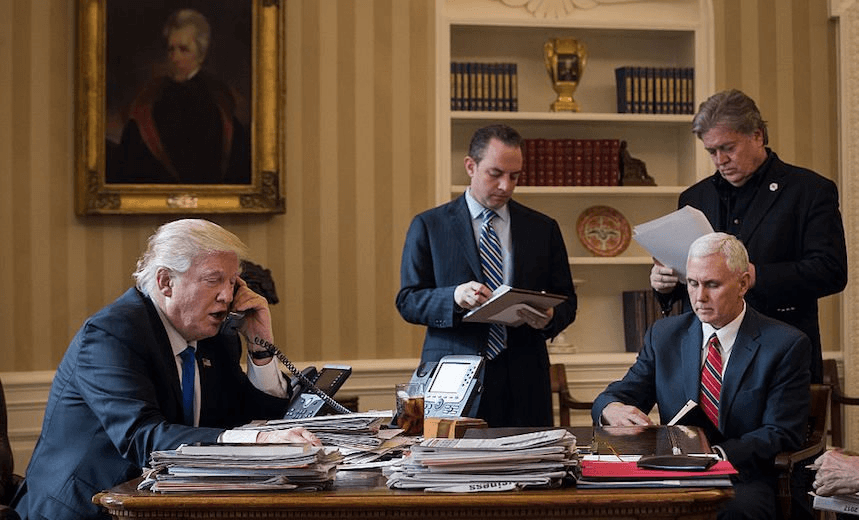President Trump reportedly called his fiery conversation with Malcolm Turnbull “the worst call so far” and later tweeted he would “study this dumb deal” to allow into the United States 1250 refugees currently being held in Australian detention centres. To help out student of international diplomacy Donald Trump – and the rest of us – Tracey Barnett explains the background to the deal.
So who are you going to believe? The American press reported that President Trump hung up on Prime Minister Turnbull. The Australian press reported that Turnbull stood up to a bully by bullying back. Somebody pushed somebody on the playground and it’s only the first days of school.
Who started it?
Well, maybe President Obama when he cut a deal last year to take 1250 of Australia’s refugees who have been held in Australia’s notorious offshore prisons on Nauru and Papua New Guinea’s Manus Island for years. In exchange, Australia agreed to take some of America’s Central American refugees.
Why the exchange?
Face saving for Turnbull, who is standing by the Australian promise never to allow boat-arriving asylum seekers to enter mainland Australia – ever, even if they are found to be genuine refugees. And for Obama, it was a mate’s push to help shutter what has become a notoriously inhumane chapter in Australian refugee cruelty.
The camps have been running for years, why the deal now?
Because the PNG Supreme Court ruled last year that Australia can’t imprison their refugees on PNG soil forever. After four years – and widespread international condemnation for their harsh human rights violations – Australia was ordered to close their notorious Manus Island detention camp.
Why doesn’t Australia just take them back?
Ever since the PNG Supreme Court ruling, Australia has been attempting to sell these people to other countries – anywhere but Australia. Why? Because successive Australian prime ministers have won lots of votes (and elections, starting as far back as Howard and the Tampa) with a pledge to never allow boat arrivals on the Australian mainland. A healthy dose of xenophobia has done wonders to tip a win in close races.
Hasn’t that pledge painted Australian PMs into a corner?
Absolutely. Successive Australian governments have now spent billions of dollars to pay other countries to take them. Indeed, they have become adept at selling their human rights obligations to a wider net of countries in our region for political favours and cash.
In the past Australia has attempted to shop these refugees (against their will) to the Solomon Islands, the Philippines and Niue, among others. These countries may have turned down the enticements, but cash-strapped Nauru and PNG became the first to sign up for the deal to open Australian-run refugee prisons on their shores. Eventually Australia ended up going further afield, paying Cambodia $55 million to take their unwanted refugees off their hands too.
Was New Zealand ever approached?
Yes, and what’s more, we quietly made a deal with them too. Australia peddled their refugees to our shores In 2013. Then prime ministers John Key and Julia Guillard emerged from a Queenstown conference with an deal in hand. We had agreed to take 150 of Australia’s refugees off its hands, every year.
What were we ‘paid’ in return?
We may never know for sure publicly. But afterward Key showcased the ‘intelligence sharing’ Australia offered as a ‘good deal for New Zealand’ (possible translation: the Australian navy would potentially alert, maybe even stop any boats bound for New Zealand shores. They may also have agreed to chase up millions in ex-pat outstanding Kiwi student loans, an issue both countries were stuck on.)
Did the refugee deal go through?
No, when Tony Abbott came in, he nixed the agreement, saying he didn’t want New Zealand to become a ‘consolation prize’. Successive Australian PMs fear New Zealand will become a ‘back door’ for Kiwi refugees to hop over to Oz.
How does it stand now?
The deal has been on hold ever since. Last year Key reiterated that the offer was still on the table. It heated up again as PNG, and dozens of international entities, pushed Australia to find a more humane solution. It’s still stalled.
Why doesn’t New Zealand just swoop in like heroes and reactivate the 150 Australian refugee deal–as we did for Tampa refugees?
Because Turnbull is still turning down New Zealand’s offer. And because he thought he had it solved with the US exchange, now looking shakier by the phone call.
Plus, on our side of the puddle, there is mixed feelings about becoming complicit in helping cement Australia’s bad boy reputation for becoming, ironically, human traffickers themselves. It rubbed many people the wrong way that Key would have actually shrunk our already tiny UN High Commission for Refugees quota from 750 to 600 to accommodate the Aussies, and every year going forward too. If every country started trading refugees with our political mates, it would seriously demean the UNHCR system constructed to help those most in need first.
Is there a possible win-win?
Yes, re-approach Australia to renegotiate the deal. This time offer to take a one-time emergency intake only, with the very public proviso that this action is to help shutter these terrible camps. The push to double the quota is strong enough that this intake should be on top of our usual quota, not instead of it.
Finally, New Zealand could take on a leadership role in our region to stop Australia from spreading this practice to our neighbours, having now become the people smugglers they so abhor.
Tracey Barnett is a columnist and founder of WagePeaceNZ, a Facebook initiative to keep Kiwis informed on refugee issues in our region and the world. She is also the author of ‘The Quiet War on Asylum’.

